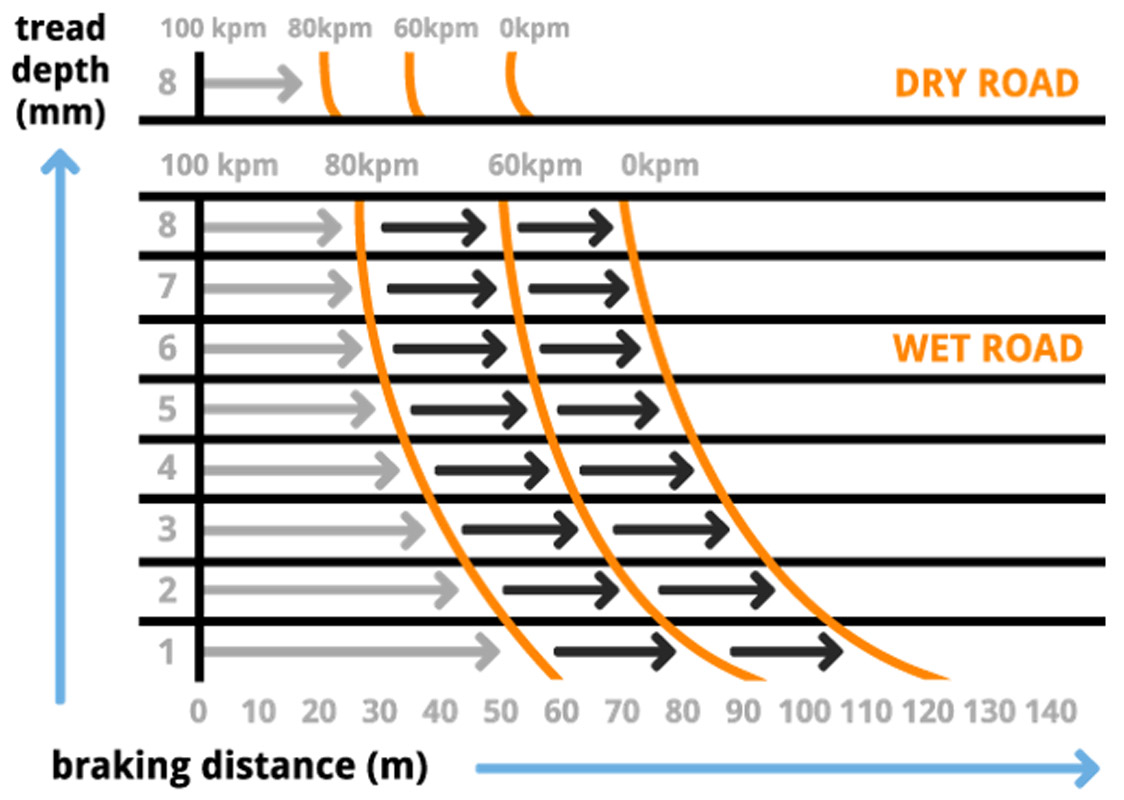TYRES AND THE LAW
Maintaining the condition of your tyres is crucial for vehicle safety, and UK law is clear on the minimum legal standards for this part of your car. There are three main laws relating to tyres that you should be aware of. These are:
- Tyre tread depth - the minimum legal tread depth is 1.6mm. This is measured across the central three-quarters of the breadth of the tyre and around the circumference of the tyre.
- Tyre pressure - your tyres should be inflated according to the manufacturer’s recommendations and around the circumference of the tyre.
- Tyre condition - your tyres should be free from signs of visual damage such as cuts, bulges or foreign objects such as glass.
Tyre Tread Depth
For the safety of you, your passengers and other road users, all of the tyres on your vehicle must have a minimum tread depth of 1.6mm.

According to tyre laws, any tyre that does not meet the minimum legal tread depth of 1.6mm is deemed unsafe. If you’re found to be driving a vehicle with tyres that have a tread depth which falls under the legal limit, you could receive a £2,500 fine and three penalty points on your licence per tyre.
However, while the legal minimum is 1.6mm, it is often recommended that you have at least 3mm of tread on each tyre. Tyre performance can start to rapidly deteriorate once the tread wears down below 3mm, and this can affect your stopping distances. For example, with tread of 1.6mm in wet weather it takes on average an extra car length to stop when driving at 50mph compared to tyres with 3mm of tread.
Tyres with low tread depth are particularly dangerous in wet and icy conditions as there is an increased chance of your tyres losing their grip of the road surface. This can be especially hazardous when driving at high speeds, such as on a motorway.
Tyre Pressures
Making sure that your tyres are inflated according to manufacturer’s recommendations is important for three reasons:
- Safety - under-inflated tyres can overheat and lead to poor vehicle handling
- Economy - over and under-inflated tyres wear out unevenly, which can cause tyres to wear out more quickly than they should and can cause misalignment over time
- Environment - incorrect tyre pressures lead to increased fuel consumption resulting in more CO2 emissions. This is not only detrimental to the environment but also increases the cost of driving.
What Is The Correct Tyre Pressure For My Car?
To find out the correct tyre pressure for your car, simply enter your vehicle registration number into our search tool.
Alternatively, you should be able to find this information in your vehicle handbook or on a label located on the inside of the driver’s door.
Once you have this information, you should then check each tyre individually using a tyre pressure gauge. This is a special device that can help determine if you need to inflate or deflate any of your tyres.
Tyre Condition
UK law states that there should be no visual damage on your tyres, so it is important to check each one for signs of wear and tear, as well as cuts and bulges. This will ensure that your vehicle is safe on the roads and help you avoid a fine and penalty points on your licence.
Talk To The Tyre Pros
“Don’t get caught out with poorly maintained tyres. As a driver, you have a responsibility to ensure that your tyres are safe, making sure that each one meets the legal requirement in terms of tread depth, pressure and overall condition. To find out more about tyre regulations and how we can help take care of your vehicle, don’t hesitate to get in touch with our team of experts today.”



